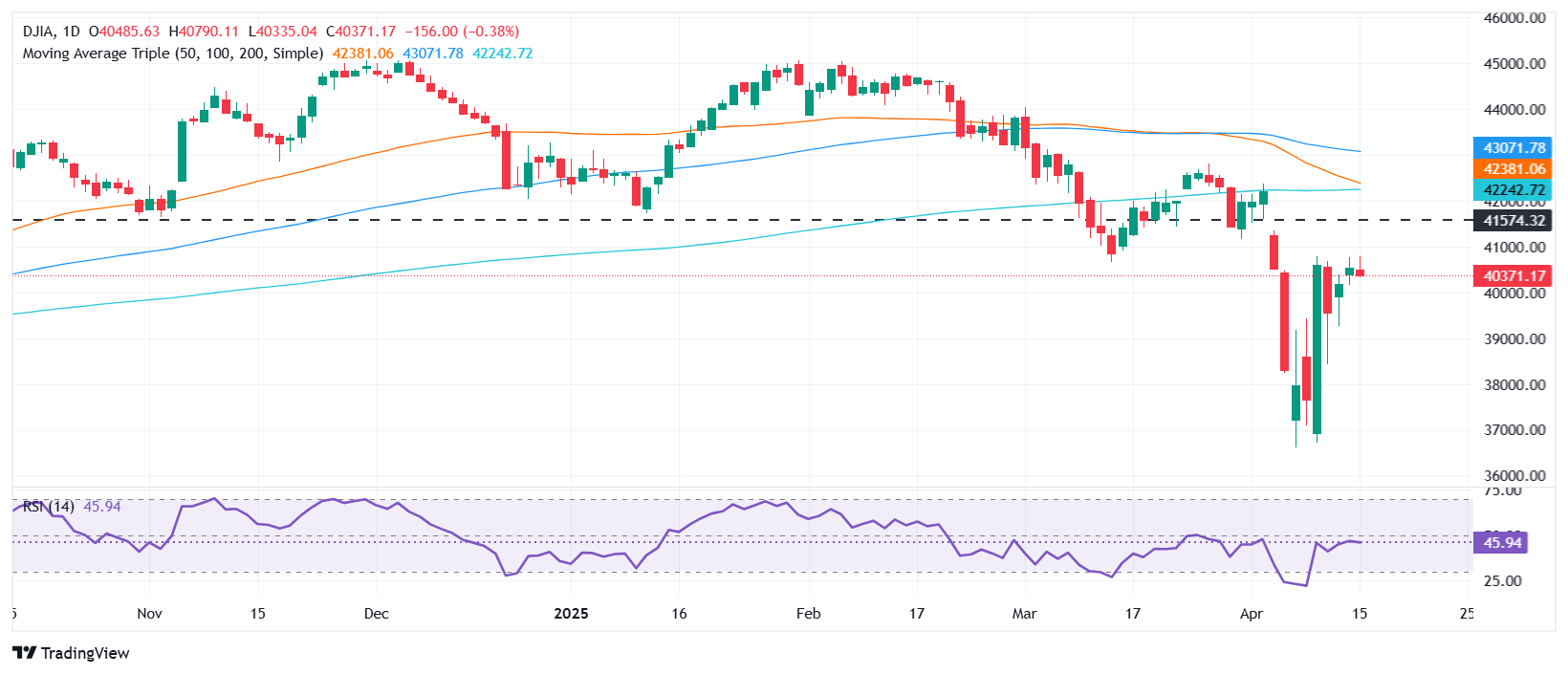Created
: 2025.04.16














![]() 2025.04.16 03:22
2025.04.16 03:22
The Dow Jones Industrial Average (DJIA) advanced earlier in the North American session by 0.3% or over 120 points. Nevertheless, optimism among investors faded recently, even though the CBOE Volatility Index (VIX) fell below 30 after spiking to a high near 60 last week.
US President Donald Trump announced that they will soon impose tariffs on imported pharmaceuticals and reiterated that the EU has been taking advantage of the US. Trump added that he is looking to help car companies and that some things will come up.
Meanwhile, China ordered domestic airlines to freeze all new Boeing jet deliveries and halted purchases of US aircraft parts. Last week, Washington excluded major electronic categories and smartphones from the 145% duties on Chinese goods. Nevertheless, comments from US President Trump and Commerce Secretary Howard Lutnick suggested these exemptions might only be temporary.
The US economic docket is light, with Retail Sales expected to be released on Wednesday. Traders should be aware that the trading week will be shortened due to the Easter holiday on Friday.
The Dow remains downward biased even though the index has clung to the 40,000 figure, underpinned mainly by an upbeat market mood. However, US President Trump comments could exert downward pressure and pave the way for a 'bearish' continuation below the 40,000 figure.
A drop below the latter will expose the April 14 low of 39,877, followed by the April 7 swing low of 36,480. On the other hand, if bulls stepped in and push prices past 40,500 the immediate level to challenge will be April 10, high at 40,909. Once cleared, 41,000 is up next.

The Dow Jones Industrial Average, one of the oldest stock market indices in the world, is compiled of the 30 most traded stocks in the US. The index is price-weighted rather than weighted by capitalization. It is calculated by summing the prices of the constituent stocks and dividing them by a factor, currently 0.152. The index was founded by Charles Dow, who also founded the Wall Street Journal. In later years it has been criticized for not being broadly representative enough because it only tracks 30 conglomerates, unlike broader indices such as the S&P 500.
Many different factors drive the Dow Jones Industrial Average (DJIA). The aggregate performance of the component companies revealed in quarterly company earnings reports is the main one. US and global macroeconomic data also contributes as it impacts on investor sentiment. The level of interest rates, set by the Federal Reserve (Fed), also influences the DJIA as it affects the cost of credit, on which many corporations are heavily reliant. Therefore, inflation can be a major driver as well as other metrics which impact the Fed decisions.
Dow Theory is a method for identifying the primary trend of the stock market developed by Charles Dow. A key step is to compare the direction of the Dow Jones Industrial Average (DJIA) and the Dow Jones Transportation Average (DJTA) and only follow trends where both are moving in the same direction. Volume is a confirmatory criteria. The theory uses elements of peak and trough analysis. Dow's theory posits three trend phases: accumulation, when smart money starts buying or selling; public participation, when the wider public joins in; and distribution, when the smart money exits.
There are a number of ways to trade the DJIA. One is to use ETFs which allow investors to trade the DJIA as a single security, rather than having to buy shares in all 30 constituent companies. A leading example is the SPDR Dow Jones Industrial Average ETF (DIA). DJIA futures contracts enable traders to speculate on the future value of the index and Options provide the right, but not the obligation, to buy or sell the index at a predetermined price in the future. Mutual funds enable investors to buy a share of a diversified portfolio of DJIA stocks thus providing exposure to the overall index.
![]()
Created
: 2025.04.16
![]()
Last updated
: 2025.04.16

FXStreet is a forex information website, delivering market analysis and news articles 24/7.
It features a number of articles contributed by well-known analysts, in addition to the ones by its editorial team.
Founded in 2000 by Francesc Riverola, a Spanish economist, it has grown to become a world-renowned information website.
We hope you find this article useful. Any comments or suggestions will be greatly appreciated.
We are also looking for writers with extensive experience in forex and crypto to join us.
please contact us at [email protected].
Disclaimer:
All information and content provided on this website is provided for informational purposes only and is not intended to solicit any investment. Although all efforts are made in order to ensure that the information is correct, no guarantee is provided for the accuracy of any content on this website. Any decision made shall be the responsibility of the investor and Myforex does not take any responsibility whatsoever regarding the use of any information provided herein.
The content provided on this website belongs to Myforex and, where stated, the relevant licensors. All rights are reserved by Myforex and the relevant licensors, and no content of this website, whether in full or in part, shall be copied or displayed elsewhere without the explicit written permission of the relevant copyright holder. If you wish to use any part of the content provided on this website, please ensure that you contact Myforex.
Myforex uses cookies to improve the convenience and functionality of this website. This website may include cookies not only by us but also by third parties (advertisers, log analysts, etc.) for the purpose of tracking the activities of users. Cookie policy